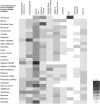Quality of Care in Performance-Based Financing: How It Is Incorporated in 32 Programs Across 28 Countries
- PMID: 28298338
- PMCID: PMC5493453
- DOI: 10.9745/GHSP-D-16-00239
Quality of Care in Performance-Based Financing: How It Is Incorporated in 32 Programs Across 28 Countries
Abstract
Objective: To describe how quality of care is incorporated into performance-based financing (PBF) programs, what quality indicators are being used, and how these indicators are measured and verified.
Methods: An exploratory scoping methodology was used to characterize the full range of quality components in 32 PBF programs, initiated between 2008 and 2015 in 28 low- and middle-income countries, totaling 68 quality tools and 8,490 quality indicators. The programs were identified through a review of the peer-reviewed and gray literature as well as through expert consultation with key donor representatives.
Findings: Most of the PBF programs were implemented in sub-Saharan Africa and most were funded primarily by the World Bank. On average, PBF quality tools contained 125 indicators predominately assessing maternal, newborn, and child health and facility management and infrastructure. Indicators were primarily measured via checklists (78%, or 6,656 of 8,490 indicators), which largely (over 90%) measured structural aspects of quality, such as equipment, beds, and infrastructure. Of the most common indicators across checklists, 74% measured structural aspects and 24% measured processes of clinical care. The quality portion of the payment formulas were in the form of bonuses (59%), penalties (27%), or both (hybrid) (14%). The median percentage (of a performance payment) allocated to health facilities was 60%, ranging from 10% to 100%, while the median percentage allocated to health care providers was 55%, ranging from 20% to 80%. Nearly all of the programs included in the analysis (91%, n=29) verified quality scores quarterly (every 3 months), typically by regional government teams.
Conclusion: PBF is a potentially appealing instrument to address shortfalls in quality of care by linking verified performance measurement with strategic incentives and could ultimately help meet policy priorities at the country and global levels, including the ambitious Sustainable Development Goals. The substantial variation and complexity in how PBF programs incorporate quality of care considerations suggests a need to further examine whether differences in design are associated with differential program impacts.
© Gergen et al.
Figures



Comment in
-
Can We Expect Results-Based Financing to Improve Quality of Care?Glob Health Sci Pract. 2017 Mar 28;5(1):1-3. doi: 10.9745/GHSP-D-17-00069. Print 2017 Mar 24. Glob Health Sci Pract. 2017. PMID: 28298339 Free PMC article.
Similar articles
-
How do performance-based financing programmes measure quality of care? A descriptive analysis of 68 quality checklists from 28 low- and middle-income countries.Health Policy Plan. 2017 Oct 1;32(8):1120-1126. doi: 10.1093/heapol/czx053. Health Policy Plan. 2017. PMID: 28549142 Free PMC article.
-
Measuring and paying for quality of care in performance-based financing: Experience from seven low and middle-income countries (Democratic Republic of Congo, Kyrgyzstan, Malawi, Mozambique, Nigeria, Senegal and Zambia).J Glob Health. 2018 Dec;8(2):021003. doi: 10.7189/jogh.08.021003. J Glob Health. 2018. PMID: 30574295 Free PMC article.
-
Performance-Based Financing to Strengthen the Health System in Benin: Challenging the Mainstream Approach.Int J Health Policy Manag. 2018 Jan 1;7(1):35-47. doi: 10.15171/ijhpm.2017.42. Int J Health Policy Manag. 2018. PMID: 29325401 Free PMC article.
-
Is Performance-Based Financing A Pathway to Strategic Purchasing in Sub-Saharan Africa? A Synthesis of the Evidence.Health Syst Reform. 2022 Mar 1;8(2):e2068231. doi: 10.1080/23288604.2022.2068231. Health Syst Reform. 2022. PMID: 35666240 Free PMC article. Review.
-
The Extent to Which Performance-Based Financing Programs' Operations Manuals Reflect Rights-Based Principles: Implications for Family Planning Services.Glob Health Sci Pract. 2019 Jun 27;7(2):329-339. doi: 10.9745/GHSP-D-19-00007. Print 2019 Jun. Glob Health Sci Pract. 2019. PMID: 31249026 Free PMC article. Review.
Cited by
-
Health management information system (HMIS) data verification: A case study in four districts in Rwanda.PLoS One. 2020 Jul 17;15(7):e0235823. doi: 10.1371/journal.pone.0235823. eCollection 2020. PLoS One. 2020. PMID: 32678851 Free PMC article.
-
High-quality health systems in the Sustainable Development Goals era: time for a revolution.Lancet Glob Health. 2018 Nov;6(11):e1196-e1252. doi: 10.1016/S2214-109X(18)30386-3. Epub 2018 Sep 5. Lancet Glob Health. 2018. PMID: 30196093 Free PMC article. Review. No abstract available.
-
Combining Theory-Driven Evaluation and Causal Loop Diagramming for Opening the 'Black Box' of an Intervention in the Health Sector: A Case of Performance-Based Financing in Western Uganda.Int J Environ Res Public Health. 2017 Sep 3;14(9):1007. doi: 10.3390/ijerph14091007. Int J Environ Res Public Health. 2017. PMID: 28869518 Free PMC article.
-
Association between infrastructure and observed quality of care in 4 healthcare services: A cross-sectional study of 4,300 facilities in 8 countries.PLoS Med. 2017 Dec 12;14(12):e1002464. doi: 10.1371/journal.pmed.1002464. eCollection 2017 Dec. PLoS Med. 2017. PMID: 29232377 Free PMC article.
-
The effects of performance-based financing on neonatal health outcomes in Burundi, Lesotho, Senegal, Zambia and Zimbabwe.Health Policy Plan. 2021 Apr 21;36(3):332-340. doi: 10.1093/heapol/czaa191. Health Policy Plan. 2021. PMID: 33491082 Free PMC article.
References
-
- Musgrove P. Financial and other rewards for good performance or results: a guided tour of concepts and terms and a short glossary. Washington, DC: World Bank; 2011. https://www.rbfhealth.org/sites/rbf/files/RBFglossarylongrevised_0.pdf Accessed February 4, 2017.
-
- Fritsche GB, Sr, Meessen B. Performance-Based Financing Toolkit. Washington, DC: World Bank; 2014. https://openknowledge.worldbank.org/handle/10986/17194 Accessed February 4, 2017.
-
- Health Results Innovation Trust Fund. Achieving results for women's and children's health: progress report 2015. Washington, DC: World Bank Group; 2015. https://www.rbfhealth.org/sites/rbf/files/2015%20Progress%20Report_0.pdf Accessed February 4, 2017.
Publication types
MeSH terms
LinkOut - more resources
Full Text Sources
Other Literature Sources
Medical
